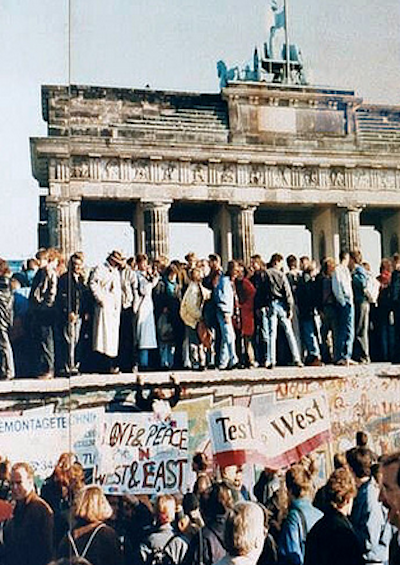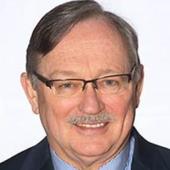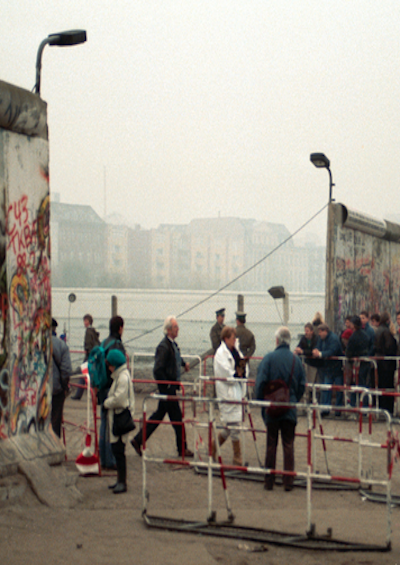The Breach of the Berlin Wall
The final hours before the fall of the Wall: An eyewitness report by an American diplomat.
November 8, 2014

After assuring ourselves that the embassy had reporting officers in place to follow events and had cabled Washington with the latest news, I headed home around 10:00 PM. My house was located in the East Berlin district of Pankow-Niederschönhausen.
Surprisingly, lots of Trabant cars were coming my way. Those iconic cars, small and plasticky, East German-designed and manufactured, began to fill the streets and were heading to the checkpoints.
Equipped with a two-cycle engine and a body made of plasticized pressed wood, you could not miss them with their little lawn-mower-like sound.
The Trabant was a perfect symbol for the East German economy. It was a rough-and-ready piece of equipment, yet people had to wait for years – and often decades – to get one.
I was all the more surprised to see so many Trabbies apparently abandoned near the Bornholmerstrasse Checkpoint. As I drove up Schönhauser Allee, I realized their drivers and passengers were crossing over the light rail S-Bahn train into West Berlin.
I knew the Bornholmerstrasse checkpoint well. I crossed it regularly. My children crossed it daily to attend the German-American John F. Kennedy Schule in Zehlendorf, West Berlin.
Now, the checkpoint was illuminated by the blazing lights of a West German television camera crew. The crew, safely ensconced in the West, was preparing to instantaneously transmit pictures around the world of what was expected to be a very real confrontation.
Checking on the checkpoint
Despite the spotlights, I could not determine precisely what was happening in the distance during the confrontation at Bornholmerstrasse. All I could make out was a steadily growing number of demonstrators gathering at the checkpoint.
Anxious East Germans, hoping to get a glimpse of West Berlin, were shouting at the guards defending the crossing. I heard them saying something, but I couldn’t understand exactly.
It sounded as if they were yelling maybe “Tor Auf” (OPEN THE GATE)! Those brave souls grew in numbers and confidently demonstrated courage.
They confronted the East German border guards charged with protecting the crossing. Led by Lieutenant-Colonel Harald Jäger, they would be the ones to carry out orders to defend the Wall.
Fire hoses, like those used later at the Brandenburg Gate, were carefully laid out by the East German authorities. They were there to repel any wall jumpers. Inside the crossing, armed border police waited.
The question running through my mind was whether the Soviet Army would stay in its barracks. In diplomatic circles, we all believed the conventional wisdom that assumed Gorbachev would intervene.
There were 380,000 Soviet soldiers in East Germany. There was no expectation that the Soviet Union, the military superpower, would give up East Germany without a fight.
I decided that I could watch this unfold on West German television from my home. Besides, I needed to get to a telephone to keep in contact with Washington and West Berlin.
Once at home, I turned on the television to see which pictures were being beamed at the East Germans from the camera at the checkpoint where I had been. Our worry – the constant modus operandi of a diplomat – would soon turn into excitement as we witnessed the fall of the Berlin Wall. Events would soon envelop us.
The Berlin Wall falls
As soon as I arrived home around 10:15 pm, I telephoned the State Department in Washington to report, as the Berlin Wall was besieged at the checkpoint and at the Brandenburg Gate.
When I called Harry Gilmore again, I had to revise me earlier statements. I said, “Harry, remember I told you that you would be seeing lots of visitors maybe in the next few days? Well, that might be tonight. It looks like things are going to break loose. We don’t know how it will unfold.”
Jon Greenwald arrived at his home and called to report Trabants on Bornholmerstrasse he had seen on his drive home as well.
Just minutes later, I witnessed on TV that the Berlin Wall was breeched at Bornholmerstrasse, where I had been just a short while earlier.
First, a wave of East Berliners came through the checkpoint signaling freedom for all East Germans. Then, a wave of people streamed across the bridge and television flashed their pictures around. They were free!
We were glued to the television after we saw those first people go through Bornholmerstrasse. Lights came on in the neighborhood. The revolution seemed to be going peacefully.
East Germans found freedom that they had fought to win. I was just happy to see the peaceful opening – no violence, just that famous East German “Rotkäppchen” (Little Red Riding Hood) champagne.
But I had a sinking feeling. I knew there were unanswered questions about those first wall jumpers at Bornholmerstrasse checkpoint.
Did they have visas? What had happened to the visa requirement? Who was in charge? Who refused to give the order to carry out the shoot-to-kill order? Why did the guards not fire?
It was Lieutenant-Colonel Jäger who avoided panic and injury among the thousands gathered at the border crossing. When he had no guidance, he gave his people the order: “Open the barrier!” Jäger’s decision opened the Wall and, soon after, the Brandenburg Gate was stormed.
Only later, speaking in a Der Spiegel magazine interview on the 20th anniversary, Lieutenant-Colonel Harald Jäger gave a full account of what happened at the border crossing in the crucial moments before he made his fateful decision.
Jäger explained, in his own words in 2009, that he had “spoken repeatedly to all officers in charge that evening, on the street, but also in his office. They demanded: “‘Harald, you’ve got to do something!’ I said: ‘What am I supposed to do? Should I let the GDR citizens leave? Or should I give the order to open fire?’
I wanted to hear what they thought. They stood together in my office and I wanted them to tell me what I should do. ‘It’s up to you, you’re the boss,’ they said.”
The other side of the story
A few months after the fall of the Berlin Wall, I learned the other part of the story. Some of the people who had used their GDR identification card to get across to the West had received a GDR exit visa stamp.
That stamp, placed on the card holder’s photo, in effect invalidated the ID card. In other words, the first people crossing the checkpoints had been expelled!
Ridding East Germany of dissidents or expelling the first demonstrators was an expedient solution. The guards had tried to save East Germany from its discontented citizens by throwing the rascals out of the country.
The rest of the story played out on live television. Tom Brokaw broadcast to America and the world. German television reported to West and East Germans alike.
The story that they told was a dream come true: the East Germans are free — and the Berlin Wall fell.
People saw on television the open Berlin Wall and hundreds of their fellow East Germans fleeing west.
Worried about the GDR not giving them visas, they decided on the spur of the moment that now was the time to go on their own. The newly announced visa requirement gave them the window.
Many thought they had only this one chance opting for freedom. They thus poured into West Berlin, thinking this opening would not last, that this was the only chance they were getting to taste freedom.
Other East Germans hopped into their Trabbies and drove many miles to get to Berlin in time to cross and not miss the only chance in their life they would have to go to Berlin.
The beauty of television in this case was that it only reported what was there to be seen – and not the new rules. In this way, Tom Brokaw and his colleagues created facts on the ground – and is was good that they did.
If the night of November 9th remained peaceful, however, that was not only due to Harald Jäger and Tom Brokaw. The East German people mustered the courage to storm the wall that had imprisoned them for decades – thus discovering the secret of freedom.
The Bastille and the Wall
The fall of the Berlin Wall is for the East Germans what the storming of the Bastille 200 years ago was for the French – the end of the old order and the end of an era.
In that November night, however, it was not only the people of the GDR who embraced freedom with courage. In far-away Moscow, the President of the Soviet Union also made a courageous decision.
Mikhail Gorbachev’s decision not to carry out the shoot-to-kill order and not to send his soldiers to restore Soviet control over East Germany was the key step that made the revolution peaceful — and what led to German and European unity.
Germans, and indeed all of us, can be thankful the Cold War ended peacefully – not least due to Gorbachev’s prudent judgment on November 9, 1989.
Conclusion
Today, 25 years after the peaceful revolution of 1989, we must not forget the lessons to be learned from it. Indeed, they seem more relevant today than at any other time during those last 25 years.
A quarter century after the fall of the wall, President Putin made a judgment call quite different from his predecessor’s.
Unlike Gorbachev, he did not embrace change. He has called the demise of the Soviet Union the greatest catastrophe of the 20th century. He has rejected the desire for freedom and prosperity, expressed by thousands of Ukrainians in Maidan square.
Putin not only has opposed their peaceful revolution politically and economically. He also ordered Russian forces to invade Ukraine and annexed Ukrainian territory. He has evidently not learned the lessons of November 1989.
Takeaways
The fall of the Berlin Wall is for the East Germans what the storming of the Bastille 200 years ago was for the French.
Mikhail Gorbachev’s decision not to send his soldiers to restore Soviet control over East Germany was key.
Gorbachev’s restraint made the revolution peaceful – and led to German and European unity.

